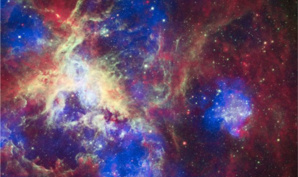A new galaxy cluster, that is thousand times bigger and “3.8 billion years” younger than our “Milky Way galaxy”, has been detected by astronomers.
At time of Big Bang, the universe was a “chaotic mess of gas and matter”. It is only “hundreds of millions of years” later that the chaos began to take an orderly shape into “distinct galaxies”. Moreover, scientists believed that it would take “several billion more years” for galaxies to coagulate into massive clusters.
Astronomers from “Massachusetts Institute of Technology (MIT), the University of Missouri and the University of Florida” jointly made the discovery of “IDCS J1426.5+3508” which is the biggest “cluster of galaxies” so far discovered that formed after four billion years of Big Bang.
The location of the said galaxy cluster has informed to be ten billion light years away from the Earth. It is thought that the mega cluster is mostly made of “thousands of individual galaxies” and is “250 trillion times more massive than the Sun”. According to the report:
“IDCS 1426 appears to be undergoing a substantial amount of upheaval. The researchers observed a bright knot of X-rays, slightly off-centre in the cluster, indicating that the cluster’s core may have shifted some hundred thousand light years from its centre”.
The conclusion of the scientists is that the dislodge of the core must have been caused by “a violent collision with another massive galaxy cluster” which resulted “the gas within the cluster to slosh around”. This kind of collision, stated the MIT assistant professor, Michael McDonald, could provide a possible explanation of the quick formation of the IDCS 1426 cluster, while other “individual galaxies” are only taking shape.
In the words of McDonald:
“In the grand scheme of things, galaxies probably didn’t start forming until the universe was relatively cool, and yet this thing has popped up very shortly after that.
“Our guess is that another similarly massive cluster came in and sort of wrecked the place up a bit. That would explain why this is so massive and growing so quickly”.
The gravitational force keeps the galaxy conglomeration “bound together”, whereby shaping the “most massive structures in the universe”, like “Virgo cluster”. Nevertheless, researchers claim that galaxy clusters that are far away in space and have formed “further back in time” are hard to come by and could prove to be an “uncertain exercise”. The first signs of IDCS 1426 were captured back in the year of 2012 with the help of “NASA’s Spitzer Space Telescope”.
References:
http://www.thehindu.com/
At time of Big Bang, the universe was a “chaotic mess of gas and matter”. It is only “hundreds of millions of years” later that the chaos began to take an orderly shape into “distinct galaxies”. Moreover, scientists believed that it would take “several billion more years” for galaxies to coagulate into massive clusters.
Astronomers from “Massachusetts Institute of Technology (MIT), the University of Missouri and the University of Florida” jointly made the discovery of “IDCS J1426.5+3508” which is the biggest “cluster of galaxies” so far discovered that formed after four billion years of Big Bang.
The location of the said galaxy cluster has informed to be ten billion light years away from the Earth. It is thought that the mega cluster is mostly made of “thousands of individual galaxies” and is “250 trillion times more massive than the Sun”. According to the report:
“IDCS 1426 appears to be undergoing a substantial amount of upheaval. The researchers observed a bright knot of X-rays, slightly off-centre in the cluster, indicating that the cluster’s core may have shifted some hundred thousand light years from its centre”.
The conclusion of the scientists is that the dislodge of the core must have been caused by “a violent collision with another massive galaxy cluster” which resulted “the gas within the cluster to slosh around”. This kind of collision, stated the MIT assistant professor, Michael McDonald, could provide a possible explanation of the quick formation of the IDCS 1426 cluster, while other “individual galaxies” are only taking shape.
In the words of McDonald:
“In the grand scheme of things, galaxies probably didn’t start forming until the universe was relatively cool, and yet this thing has popped up very shortly after that.
“Our guess is that another similarly massive cluster came in and sort of wrecked the place up a bit. That would explain why this is so massive and growing so quickly”.
The gravitational force keeps the galaxy conglomeration “bound together”, whereby shaping the “most massive structures in the universe”, like “Virgo cluster”. Nevertheless, researchers claim that galaxy clusters that are far away in space and have formed “further back in time” are hard to come by and could prove to be an “uncertain exercise”. The first signs of IDCS 1426 were captured back in the year of 2012 with the help of “NASA’s Spitzer Space Telescope”.
References:
http://www.thehindu.com/






